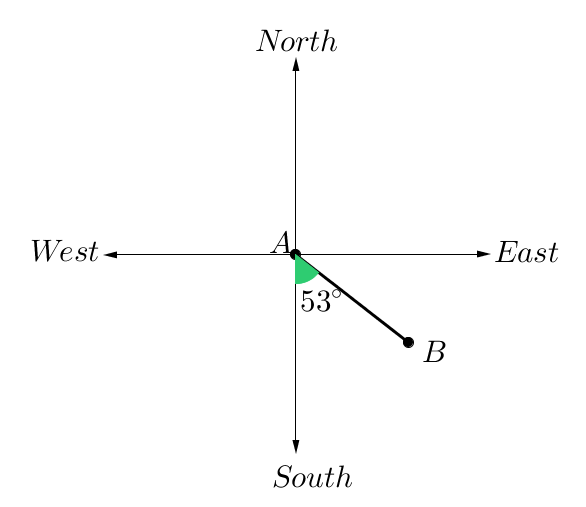Bearings
In surveying and navigation, bearings are used to help identify the location of an object.
The four main directions of a compass are known as cardinal directions. They are north (N), east (E), south (S) and west (W).

True bearings
Also known as a three-figure bearing, a true bearing is:
- measured from north ($N$N)
- measured in a clockwise direction
- written using three figures
$T$T is often but not always used to indicate a true bearing. If the angle measure is less than $100^\circ$100° it would be written like $040^\circ$040° or $040^\circ T$040°T.
To use true bearings to describe the location of a plane at point $B$B from the airport at point $A$A :
- place the centre of a compass on the starting point, in this case the airport.
- starting at North, rotate clockwise until we get to the line $AB$AB.
- write the angle as the true bearing of point $B$B.

The bearing of $B$B from $A$A is $127^\circ$127° or $127^\circ$127°$T$T.
The diagram below describes the bearing of $P$P from $O$O. Rotating clockwise from North, we get an angle of $55^\circ$55°.

Since this measure is less than three digits, we put a $0$0 in front of it so the true bearing of $P$P is $055^\circ$055°.
Consider the bearing of $O$O from $P$P . Since alternate angles are equal and we are starting at $P$P the true bearing would be $180^\circ+55^\circ=235^\circ$180°+55°=235°.
Compass bearings
A compass bearing describes the location of a point using:
- the starting direction of either north or south;
- the acute angle needed to rotate
- the direction to rotate, east or west.
To describe the position of point $B$B from $A$A we would say:
"Starting at South, I then rotate $53^\circ$53° towards East."

We can write this mathematically as $S\ 53^\circ E$S 53°E
Which one first?
The bearing needed or used completely depends on which position comes first. Have a look at the applet below, it quickly shows you how the angle changes depending on if we are measuring the bearing of $A$A from $B$B or $B$B from $A$A.
Practice questions
Question 1
Consider the point $A$A.

Find the true bearing of $A$A from $O$O.
What is the compass bearing of point $A$A from $O$O?
$\editable{}$ $\editable{}$$^\circ$° $\editable{}$
Question 2
What is the true bearing of Southwest?
Question 3
In the figure below, point $B$B is due East of point $A$A. We want to find the position of point $A$A relative to point $C$C.

Find the true bearing of point $A$A from point $C$C.
What is the compass bearing of point $A$A from point $C$C?
$\editable{}$ $\editable{}$$^\circ$° $\editable{}$
Applications
Applications cover many fields in navigation and surveying including search and rescue, mining and tunnel engineering.
Worked example
Example 1
A slightly lost hiker walks $300$300 m east before turning south walking another $800$800 m. What is the hikers three-figure and compass bearings from the original position (rounded to one decimal place)?
Think: It will be easiest to first visualise the situation by drawing a diagram, such as this one:

For the three-figure bearing, the angle we want to find has been marked. It is equal to $90^\circ$90°$+$+the angle inside the triangle, which we can find using trigonometry. We can then use this to find the compass bearing.
Do: The three-figure bearing is:
| $90+\tan^{-1}\left(\frac{800}{300}\right)$90+tan−1(800300) | $=$= | $90+\tan^{-1}\left(\frac{8}{3}\right)$90+tan−1(83) |
| $=$= | $90+69.44395\ldots$90+69.44395… | |
| $=$= | $159.4$159.4 (one d.p.) |
So the three-figure bearing is $159.4$159.4$^\circ$°.
To determine this as a compass bearing, we want to know the acute angle made with the North-South line. This is $180^\circ-159.4^\circ=20.6^\circ$180°−159.4°=20.6°.
Looking back at the diagram, we can see that this bearing is closer to South, and on the East side, so the compass bearing is $S\ 20.6^\circ E$S 20.6°E.
Practice questions
Question 4
The position of a ship S is given to be $20$20 kilometres from P, on a true bearing of $0$0$49$49$^\circ$°T.
The position of the ship can also be given by its $\left(x,y\right)$(x,y) coordinates.

If the ship's $x$x-coordinate is $x$x, find $x$x to one decimal place.
If the ship's y-coordinate is $y$y, find $y$y to one decimal place.
Question 5
A yacht sailed in a direction so that its final position was $248$248 kilometres west and $225$225 kilometres south of its starting point.

If the bearing on which the yacht sailed is $b$b$^\circ$°, find the value of $b$b.
Round your answer to one decimal place.
If the boat has sailed a total of $d$d metres, find $d$d.
Round your answer to one decimal place.